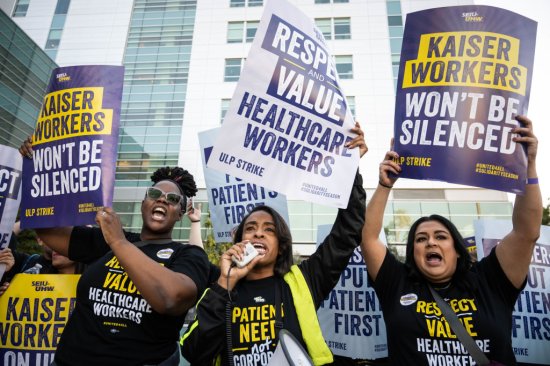
Unions behind the biggest health care strike in U.S. history blame staffing shortages for poor patient care and difficult working conditions.
More than 75,000 unionized Kaiser Permanente health care workers walked off the job on Oct. 4 in the largest health care industry strike in U.S. history. Picketing began early this morning in Washington, D.C., and Virginia, with employees following suit at Kaiser facilities in Colorado, California, Oregon, and Washington after a fruitless final attempt overnight to settle a contract with chief executives at the non-profit health system. The strike will last a maximum of three days before the coalition will send members back to work amid further negotiation, though D.C. workers are striking for one day only.
[time-brightcove not-tgx=”true”]The eight unions involved in the strike cover 40% of Kaiser Permanente’s workforce, many of whom have expressed concerns with insufficient staffing levels they say have persisted since the pandemic, causing lapses in both patient care and the provision of fair labor practices. Though doctors, some nurses, and other workers not covered by the Coalition of Kaiser Permanente Unions will be working throughout the strike in order to keep hospitals and emergency departments open, the organization has asked for patience from the nearly 13 million Americans it covers, who can expect high wait times and rescheduled non-urgent procedures and appointments.
Read More: American Health Care Faces a Staffing Crisis And It’s Affecting Care
“Kaiser used to hold itself out as the best place to get care and the best place to work, but it is now failing at both. Kaiser can and must do better,” Linda Bridges, president of the OPEIU Local 2 union that represents 8,000 Mid-Atlantic Kaiser workers, said shortly before the workers’ existing contract expired on Sep. 30.
The resulting strike is the latest to occur as tensions over labor rights ratchet up in numerous U.S. industries. According to the U.S. Bureau of Labor Statistics, 2022 saw a total of 120,600 workers involved in 23 major work stoppages. Along with a United Auto Workers walkout that began in September, the Kaiser strike brings the 2023 total to more than 400,000 with nearly 3 months left in the year. The Kaiser Permanente strike is also a reflection of the widespread problem understaffing has become in the U.S. health care industry. Many of the same concerns were expressed by the 7,000 nurses at two New York City hospitals who protested for three days in January. Because of unions’ commitment to prioritizing patient care, strikes in the health care industry are subject to special requirements that can make them more difficult to execute, including providing organizations with 10 days notice.
More From TIME
During COVID, “there was sort of a rupture in the relationship between health care workers and their employers,” says Patricia Pittman, director of the Health Workforce Research Center at George Washington University’s Milken Institute School of Public Health. “There’s a sense among the health care workforce, that, frankly, nobody cared about their safety.”
What’s At Stake
The striking workers make up nearly all elements of patient care at Kaiser clinics, and include emergency department technicians, pharmacists, housekeepers, and hundreds of other positions. “These are the people who you’re going to see from the moment you walk up to the front desk to the nurses [who] are at your bedside,” says Renee Saldana, a spokesperson for California-based SEIU-UHW, the largest of the striking unions.
In California, where Kaiser is the single largest provider of health care, a May survey of 33,000 workers across health systems conducted by a state health care justice union found that a majority of respondents had witnessed delayed or denied patient care due to staffing shortages. Seventy-four percent specifically cited not having enough time to care for patients properly, while 83% reported understaffing in their departments.
“Leadership is up against the wall already, because so many people are quitting,” says Pittman. The resulting impacts are present at many non-Kaiser hospitals, she adds: “We see it with the CDC reporting this huge spike in hospital-acquired infections and other patient safety episodes.”
The union coalition cites executives’ unwillingness to invest in staffing as a key cause of these issues. The coalition is demanding not only increased hiring beyond the 10,000 new hire goal for 2023 established earlier this week by Kaiser, but also higher pay and better training, both of which they say could help prevent high turnover in the face of industry-wide burnout and cost-of-living crises in key states where Kaiser operates. The currently proposed 4% maximum annual wage increase in Kaiser’s contracts is insufficient, the coalition says.
Strikers also oppose a proposed change by Kaiser leaders that would make it easier for jobs to be subcontracted and outsourced to independent health care companies, a practice that coalition representatives say prioritizes lower-paid work at the risk of workplace stability.
The strike could also portend similar action in other U.S. health systems, says Pittman, given that Kaiser had for many years been “held up” as a model for labor rights and salary stability in the industry, due in part to forward-looking negotiations in the late ‘90s.
“It’s particularly shocking that this could be happening at Kaiser Permanente,” she says, “and sort of does not bode well for the rest of the healthcare organizations in the country.”